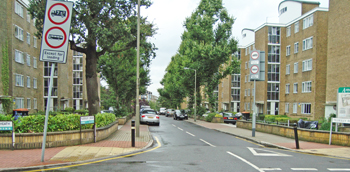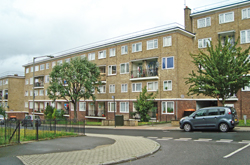for Discharged Soldiers
Chronic long-stay
In 1915 Gifford House was lent by Mr and Mrs John Douglas Charrington (of the brewery family) for use as an auxiliary hospital for convalescent servicemen. The house, located in 'Millionaire's Row', stood in its own grounds with a bowling green at the back - all surrounded by cypress trees.
Gifford House Auxiliary Hospital opened on 21st June 1915 and was affiliated to the King George Hospital in Stamford Street. It was a Grade A hospital, accepting cot cases (i.e. the bed ridden) and initially had 80 beds, which were soon increased to 140. It was staffed by members of the London/96 Voluntary Aid Detachment (V.A.D.) of the Order of St John.
In September 1915 the King and Queen visited the Hospital, as well as its neighbour, Queen Mary's Convalescent Auxiliary Hospital at Dover House.
By January 1916 the Hospital had 190 beds and, by August 1916, 210 beds.
After the war, by March 1919, the Hospital had 230 beds.
It was decided that the house should temporarily become a hospital-home for disabled ex-servicemen. Lady Ripon, the President of the Compassionate Fund and Gift Stores at the King George Hospital, had been determined to establish such an institution. However, she died in October 1917 before suitable premises could be found. Her friends, though, were determined to carry the project through in her memory.
The Charringtons offered the house for further use until the end of 1920, by which time it was hoped that a permanent site for the hospital-home would have been found.
On 9th July 1919 Queen Alexandra formally opened the Queen Alexandra Hospital Home for Discharged Soldiers (in memory of Lady Ripon).
The patients were discharged servicemen who needed continuing care. They had been referred by the Ministry of Pensions, who also gave a capitation grant to the Home.
In July 1919 the Hospital Home had over 100 beds, but only 51 patients - 41 of whom were paralysed. Most had been transferred from the King George Hospital. (In July 1919 one of the revolving shelters from the roof garden of the King George Hospital was also transferred to the Hospital Home).
The ground floor of Gifford House contained a ballroom, which had been converted into a ward for ambulant or wheelchair-bound patients. The first floor rooms were used for paraplegic patients. Female members of the V.A.D. undertook nursing care of the patients, dealing with their dressings, while male orderlies did the cooking and any manual work.
The house's concert room was converted into a Day Room for the patients; a slope was built to provide wheelchair access. A small billiard table was installed.
Despite being discharged from the Army, the patients lived under military rules and wore 'hospital blues' - the uniform of the convalescent soldier, which consisted of a saxe blue suit (the jacket lapels had to be clay-piped every day), a grey shirt, a red tie and a regimental hat and badge.
Breakfast was usually a hard-boiled egg with a hunk of bread, while the other meals were stew and dumplings or boiled beef. Each patient provided his own cutlery, as this was part of his kit as a serving soldier.
From time to time Mr Charrington would visit and give each patient one cigarette.
In December 1919 the first edition of The Gifford Journal was published, containing material provided by the patients and their visitors, and the staff.
In 1920 the Hospital Home became affiliated with the Tooting Neurological Hospital, also run by the Ministry of Pensions.
In July 1920 the workshops at the neighbouring Queen Mary Convalescent Auxiliary Hospital in Roehampton House closed. The Ministry of Pensions purchased their plant and two electric lathes, and installed them in the Massage Rooms of the Hospital Home. The Ministry provided all materials used during the instruction courses and, afterwards, patients could make items to sell using their own material. As well as carpentry as a therapeutic occupation, basket-making was introduced and, in 1922, mat- and rug-making.
For leisure and amusement, the Hospital Home had an orchestra and various clubs - the Camera Club, the Canary Club and the Pigeon Club (for which Mr Charrington loaned the lofts - these were in the grounds and therefore accessible to wheelchair users. Some 50 birds were kept). Outings and concerts were arranged, as well as charabanc trips (some patients went in ambulances) and river trips.
At the end of 1920 Mr Charrington agreed to offer the house for another 15 months, as a permanent site for the Hospital Home had not yet been identified.
The problems of impermanence at the site and financial insecurity continued to plague the management committee but, when Mr Charrington offered to sell the house and 14 acres of grounds to the committee for £30,000, the funds proved impossible to find. The Red Cross Society believed the patients should be transferred to its permanent home in Richmond - the Star and Garter Home, which was being built (it opened in 1924).
The Joint War Committee announced that it would cease to provide funding on 1st September 1924, although it did not.
In 1926 the Queen became Patron of the Hospital Home.
Finally, in 1932, a house in Boundary Road, Worthing, was identified as suitable premises for the Hospital Home. The patients were transferred there in August 1933, when it was renamed Gifford House in memory of its Roehampton origins.
The Roehampton site closed in September 1933.
Present status (August 2010)After the Charringtons lent the house to War Office in 1915, no private resident lived there again.
During WW2 the house and its grounds were used for training purposes.
After the war the house stood derelict until the 1950s, when it was demolished by the LCC for the building of the Ashburton Estate. Its site is roughly where Tildersley Road joins Putney Heath.
The icehouse of Gifford House survives. It is located on the east side of Putney Park Lane, at Innes Gardens, and is Grade II listed.
The Queen Alexandra Hospital Home in Worthing continues to provide residential and respite care for ex-service personnel who require specialist nursing care and rehabilitation, including those with acquired brain injury. The Hospital Home has 60 beds for permanent or short-stay patients aged 18 years or over.

The site of the Hospital Home is approximately where Tildesley Road joins Putney Heath.

The Ashburton Estate (above and below) was built on the site of the house and its grounds.

(Author unstated) 1915 Care of the wounded. British Journal of Nursing, 19th July, 48.
(Author unstated) 1915 Nursing and the war. British Journal of Nursing, 25th September, 251.
(Author unstated) 1917 List of the various hospitals treating military cases in the United Kingdom. London, H.M.S.O.
(Author unstated) 1919 Disabled soldiers at Roehampton. The Times, 9th July.
(Author unstated) 1926 Nursing echoes. British Journal of Nursing (March), 49.
Farrant DS 1997 The Queen Alexandra Hospital Home. A History. Chichester, Phillimore.
http://1914-1918.invisionzone.com
https://ww1wandsworth.wordpress.com
www.qahh.org.uk
www.rohcollections.org.uk
www.tipsimages.it
www.worthingsp.blogspot.co.uk
Return to home page